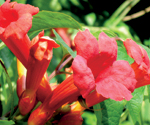Applauding the trumpet vine
Mark Griffiths encountered some examples of trumpet vine in Worcester College gardens that he has never seen before


Old gardens can be great generators of new plants. Hybrids can arise unbidden, and self-sown seedlings sometimes outshine their parents. Seasoned trees and shrubs sport chance mutations that may be tomorrow's darling dwarf, or gold-leaved or double-flowered cultivar. For me, however, by far the best of all these finds is, strictly speaking, a non-novelty. It is the secret survivor, a specimen of some splendid old variety that has long been thought extinct, or which has never even ventured beyond the ancient walls of the garden where it lurks. Encountering such a plant is like discovering a lost masterpiece in some cobwebby attic.
Not that that last simile should be taken too literally in the case of Worcester College, Oxford. The gardens there are far from derelict. They do, however, contain one or two venerable examples of varieties that I have never seen before. The most magnificent of these is a trumpet vine (Camp-sis) that covers the wall of the recently restored Alfred Parsons Rose Garden (Country Life, August 9) and which, in the century or more since its planting, has also asserted itself elsewhere around the college.
There are two species of Campsis: C. radicans, introduced from North America in the first half of the 17th century, and C. grandiflora, which arrived from the Far East in about 1800. Both are rampant woody vines with handsome pinnate leaves and typically orange-red trumpets in high to late summer. The American clings to walls by its roots, ivy-style, and bears tight clusters of tubular to funnel-shaped flowers. The Asian usually lacks adhesive roots and is less hardy. It compensates with larger blooms, that are broadly bell-shaped and in longer, branching sprays. These two species have offspring, a garden hybrid named Campsis x tagliabuana, after Tagliabue Fratelli, the Milanese nursery where it first came to light. Dating from the 1880s, the best-known selection of this cross is Madame Galen, a robust plant with corrugated, dark-green leaflets and foxglove flowers in tangerine and salmon shades.
Given rich soil, plenty of water and some initial support, Campsis radicans and C. x tagliabuana will attach themselves to a sunny wall and begin to flower profusely after a few years. When necessary, prune them once the worst frosts are over, reducing established plants to a framework of main stems and short spurs of last season's growth. Cold-shy and non-clinging Campsis grandiflora requires rather more care and should be tied to a trellis or wires in a warm spot with side shelter.
The trumpet vine could be termed the vertical counterpart of hot-coloured border perennials (such as Crocosmia Lucifer), now so fashionable, and garden centres have res-ponded by offering a range of them, including some newcomers. Recent selections of Campsis x tagliabuana include Dancing Flame in orange-throated pomegranate red, and the amber and apricot Indian Summer. In C. radicans, the cultivars Tango (crimson) and Flamenco (vermilion) are worth putting through their paces.
Most intriguing of all is C. grandiflora Morning Calm. With long trusses of wide, golden-eyed flowers in shades of coral and peach, this selection of the Chinese species is said to be as hardy as its New World cousin. I hope so. Meanwhile, back at Worcester College, the panama is pushed back for some serious head-scratching. Although it is certainly Campsis radicans, I can't fit the college's trumpet vine to any cultivar I know.
A heroic specimen in every respect, it's unruffled by cold and gloom, has stout stems, luxuriant leaves, and blooms from midsummer until early autumn, massed with chalices up to 4in long and 2½in across. In youth or sun, the blooms are a deep glowing carmine; in shade and with age, a fathom-less ruby. Overall, they possess an incarnadine beauty, and I suspect this old plant may be unique, or at least something long forgotten by the horticultural trade. If you grow an American trumpet vine that matches its description or can identify it I'd be most delighted to know.
Exquisite houses, the beauty of Nature, and how to get the most from your life, straight to your inbox.
Country Life is unlike any other magazine: the only glossy weekly on the newsstand and the only magazine that has been guest-edited by His Majesty The King not once, but twice. It is a celebration of modern rural life and all its diverse joys and pleasures — that was first published in Queen Victoria's Diamond Jubilee year. Our eclectic mixture of witty and informative content — from the most up-to-date property news and commentary and a coveted glimpse inside some of the UK's best houses and gardens, to gardening, the arts and interior design, written by experts in their field — still cannot be found in print or online, anywhere else.
